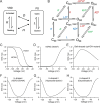This is a preprint.
An Allosteric Model for Electromechanical Coupling in Cardiac CNBD Channels
- PMID: 40766500
- PMCID: PMC12324303
- DOI: 10.1101/2025.07.28.666606
An Allosteric Model for Electromechanical Coupling in Cardiac CNBD Channels
Abstract
Ion channels in the cyclic nucleotide-binding domain (CNBD) family, including hyperpolarization-activated cyclic nucleotide-gated (HCN) channels and human ether-à-go-go-related gene (hERG) channels, play pivotal roles in regulating cardiac action potentials. HCN channels are uniquely activated by hyperpolarization, rather than depolarization, a critical mechanism for controlling the involuntary pacemaker activity of the heart. In contrast, hERG channels are depolarization-activated and mediate K+ currents essential for action potential repolarization. Notably, certain hERG mutations, including those associated with long-QT syndrome, can induce biphasic activation by both hyperpolarization and depolarization. Despite the diverse voltage-dependent gating behaviors observed in CNBD channels, a unified mechanistic framework remains lacking. Here, we propose an allosteric model for their electromechanical coupling, featuring a single voltage-sensor transition coupled to two distinct conformational coupling modes between voltage-sensing and pore domains. With only three or four free parameters, this model recapitulates the biphasic U-shaped and bell-shaped conductance-voltage relationships commonly seen in CNBD channels. Fluorescence anisotropy-based homo-FRET experiments employing site-specifically incorporated noncanonical amino acids provide further support for the hypothesis, suggesting that the S5 helix movement plays a key role in hyperpolarization-dependent activation, while S4-S6 helix interactions are required for depolarization-dependent gating.
Conflict of interest statement
Competing Interests The author declares no competing interest.
Figures



Similar articles
-
Propofol rescues voltage-dependent gating of HCN1 channel epilepsy mutants.Nature. 2024 Aug;632(8024):451-459. doi: 10.1038/s41586-024-07743-z. Epub 2024 Jul 31. Nature. 2024. PMID: 39085604 Free PMC article.
-
Domain coupling in allosteric regulation of SthK measured using time-resolved transition metal ion FRET.Elife. 2025 Aug 12;14:RP106892. doi: 10.7554/eLife.106892. Elife. 2025. PMID: 40792615 Free PMC article.
-
Voltage sensors.Mol Pharmacol. 2025 Feb;107(2):100011. doi: 10.1016/j.molpha.2024.100011. Epub 2024 Dec 12. Mol Pharmacol. 2025. PMID: 40023511 Review.
-
Domain Coupling in Allosteric Regulation of SthK Measured Using Time-Resolved Transition Metal Ion FRET.bioRxiv [Preprint]. 2025 May 20:2025.03.31.646362. doi: 10.1101/2025.03.31.646362. bioRxiv. 2025. Update in: Elife. 2025 Aug 12;14:RP106892. doi: 10.7554/eLife.106892. PMID: 40236086 Free PMC article. Updated. Preprint.
-
The Black Book of Psychotropic Dosing and Monitoring.Psychopharmacol Bull. 2024 Jul 8;54(3):8-59. Psychopharmacol Bull. 2024. PMID: 38993656 Free PMC article. Review.
References
-
- Hille B., Ion Channels of Excitable Membranes (Sinauer Associates, ed. 3rd 2001).
-
- DiFrancesco D., Characterization of single pacemaker channels in cardiac sino-atrial node cells. Nature 324, 470–473 (1986). - PubMed
-
- Robinson R. B., Siegelbaum S. A., Hyperpolarization-activated cation currents: from molecules to physiological function. Annu Rev Physiol 65, 453–480 (2003). - PubMed
-
- Craven K. B., Zagotta W. N., CNG and HCN channels: two peas, one pod. Annu Rev Physiol 68, 375–401 (2006). - PubMed
Publication types
Grants and funding
LinkOut - more resources
Full Text Sources
